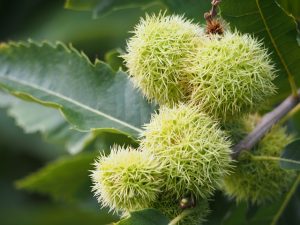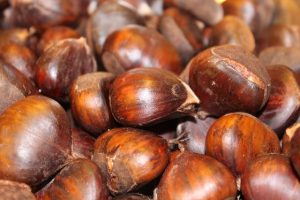(Castanea sativa)
There’s nothing quite like the taste of a sweet chestnut, and as well as tasting delicious, they are often a reminder of childhood afternoons spent gathering them and taking them home to roast on the fire or in the oven.
What do sweet chestnuts look like?
 Sweet Chestnut trees are often seen in woodland throughout the UK. They have a bright coloured green leaf that has serrated edges.
Sweet Chestnut trees are often seen in woodland throughout the UK. They have a bright coloured green leaf that has serrated edges.
The outer husks are a green colour that mature to brown, and are covered in spikes. Opening them can be a challenge, but one that’s worth a pricked finger or two. The sweet chestnuts are clustered inside, and they are a rich, dark brown in colour.
 Do not mistake a chestnut for a conker! Chestnuts are flatter and not as big.
Do not mistake a chestnut for a conker! Chestnuts are flatter and not as big.
When to look for Sweet Chestnuts
Chestnuts are ready to gather in late autumn, especially after some windy weather. You will find the husks littering the floor, and poking about amongst them you are sure to find some tasty treats.
The chestnuts must be ripe before eating. Ripe sweet chestnuts are of a good size and are hard. If you find ones that are small and soft, try again a week or two later in the season.
How to eat and store Sweet Chestnuts
Uncooked nuts do have a tendency to go mouldy, so avoid letting them sweat. You can keep them for a couple of weeks in a paper bag in a cool, dry place.
Freezing sweet chestnuts is also a good way of storing them, although it does affect the texture of the nut.
One of the most fun ways to eat sweet chestnut is to roast them on a fire or in an oven. Prick them with a fork first as steam builds up under the shells, and this can result in pieces of chestnut being propelled through the room.
You can also cook sweet chestnuts by putting them in a bowl of just boiled water for a while to allow the skins to soften. Remove them and peel the shell off when cool enough to handle.
Sweet chestnuts can also be pickled or preserved. They add an interesting flavour to lots of different sweet and savoury dishes.
Sweet chestnuts have a softer texture than other nuts, and are starchy. They can be ground into a gluten free flour to be used in breads, cakes, pastries and biscuits.
Sweet Chestnuts are a tasty addition to a forager’s harvest, and they are in abundance in autumn. Make sure you gather plenty and enjoy!
Back to list of wild edible foods




